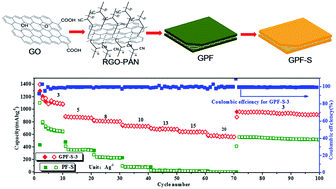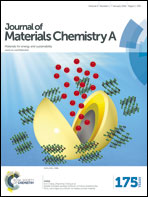Graphene-directed two-dimensional porous carbon frameworks for high-performance lithium–sulfur battery cathodes†
Abstract
Graphene-directed two-dimensional (2D) nitrogen-doped porous carbon frameworks (GPF) as the hosts for sulfur were constructed via the ionothermal polymerization of 1,4-dicyanobenzene directed by the polyacrylonitrile functionalized graphene nanosheets. As cathodes for lithium–sulfur (Li–S) batteries, the prepared GPF/sulfur nanocomposites exhibited a high capacity up to 962 mA h g−1 after 120 cycles at 2 A g−1. A high reversible capacity of 591 mA h g−1 was still retained even at an extremely large current density of 20 A g−1. Such impressive electrochemical performance of GPF should benefit from the 2D hierarchical porous architecture with an extremely high specific surface area, which could facilitate the efficient entrapment of sulfur and polysulfides and afford rapid charge transfer, fast electronic conduction as well as intimate contact between active materials and the electrolyte during cycling.


 Please wait while we load your content...
Please wait while we load your content...